wiring JEEP WRANGLER 2013 JK / 3.G Owners Manual
[x] Cancel search | Manufacturer: JEEP, Model Year: 2013, Model line: WRANGLER, Model: JEEP WRANGLER 2013 JK / 3.GPages: 666, PDF Size: 5.16 MB
Page 36 of 666

1. Roll down the glass window to prevent any damage.
2.
Remove the hinge pin screws from the upper and lower
outside hinges (using a #T50 Torx® head driver).
NOTE:The hinge pin screws and nuts can be stowed in
the rear cargo tray located under the rear loadfloor. 3.
Unplug the wiring harness connector under the instru-
ment panel by pressing the tab at the top of the connector
and pulling to disconnect.
NOTE:If the red latch on the connector is locked, pull the
red latch down. This will unlock the connector tab, allowing
the tab to be pressed down and enabling the harness to be
disconnected.
Door Removal Warning LabelHinge Pin Screw
34 THINGS TO KNOW BEFORE STARTING YOUR VEHICLE
Page 37 of 666
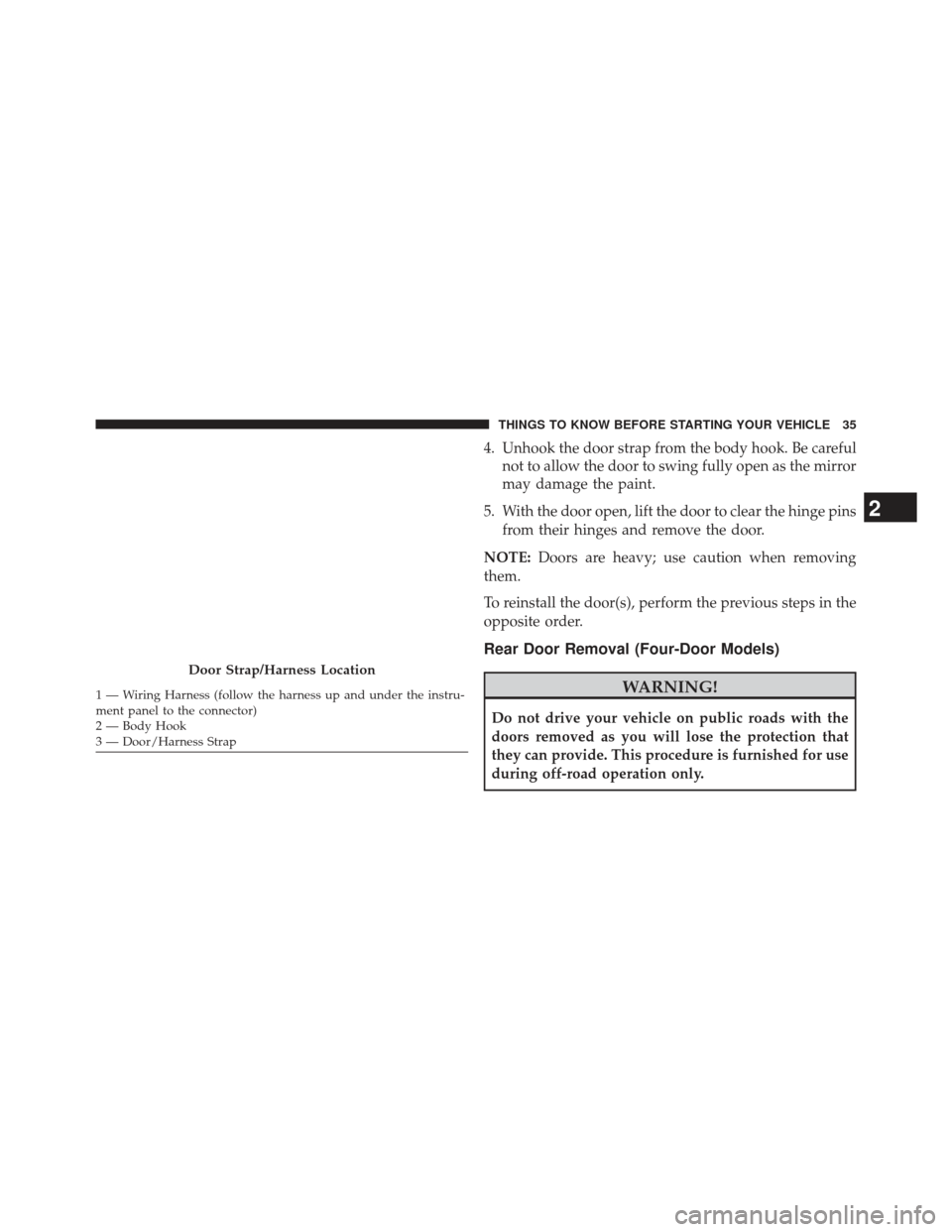
4. Unhook the door strap from the body hook. Be carefulnot to allow the door to swing fully open as the mirror
may damage the paint.
5. With the door open, lift the door to clear the hinge pins from their hinges and remove the door.
NOTE: Doors are heavy; use caution when removing
them.
To reinstall the door(s), perform the previous steps in the
opposite order.
Rear Door Removal (Four-Door Models)
WARNING!
Do not drive your vehicle on public roads with the
doors removed as you will lose the protection that
they can provide. This procedure is furnished for use
during off-road operation only.
Door Strap/Harness Location
1 — Wiring Harness (follow the harness up and under the instru-
ment panel to the connector)
2 — Body Hook
3 — Door/Harness Strap
2
THINGS TO KNOW BEFORE STARTING YOUR VEHICLE 35
Page 39 of 666
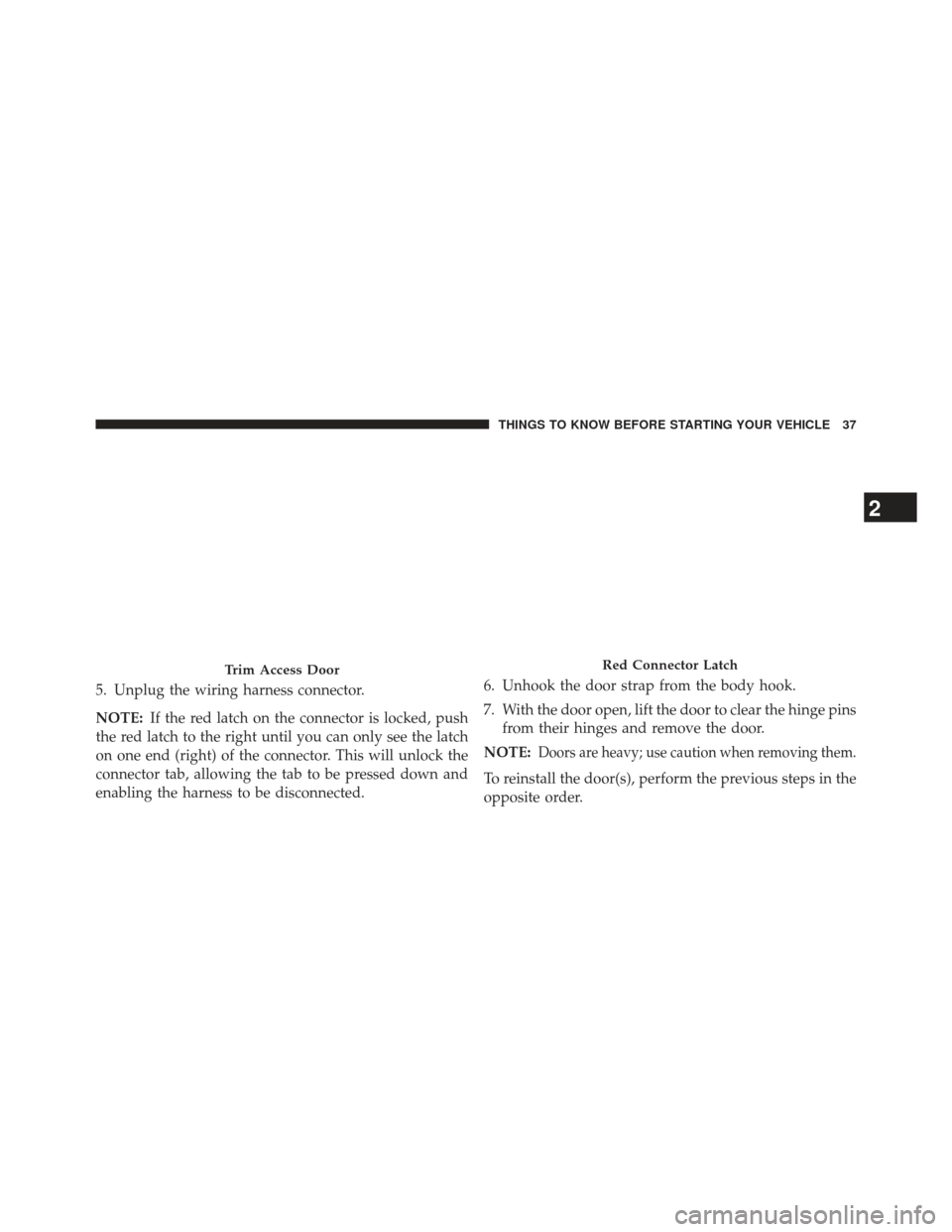
5. Unplug the wiring harness connector.
NOTE:If the red latch on the connector is locked, push
the red latch to the right until you can only see the latch
on one end (right) of the connector. This will unlock the
connector tab, allowing the tab to be pressed down and
enabling the harness to be disconnected. 6. Unhook the door strap from the body hook.
7. With the door open, lift the door to clear the hinge pins
from their hinges and remove the door.
NOTE:
Doors are heavy; use caution when removing them.
To reinstall the door(s), perform the previous steps in the
opposite order.
Trim Access DoorRed Connector Latch
2
THINGS TO KNOW BEFORE STARTING YOUR VEHICLE 37
Page 74 of 666
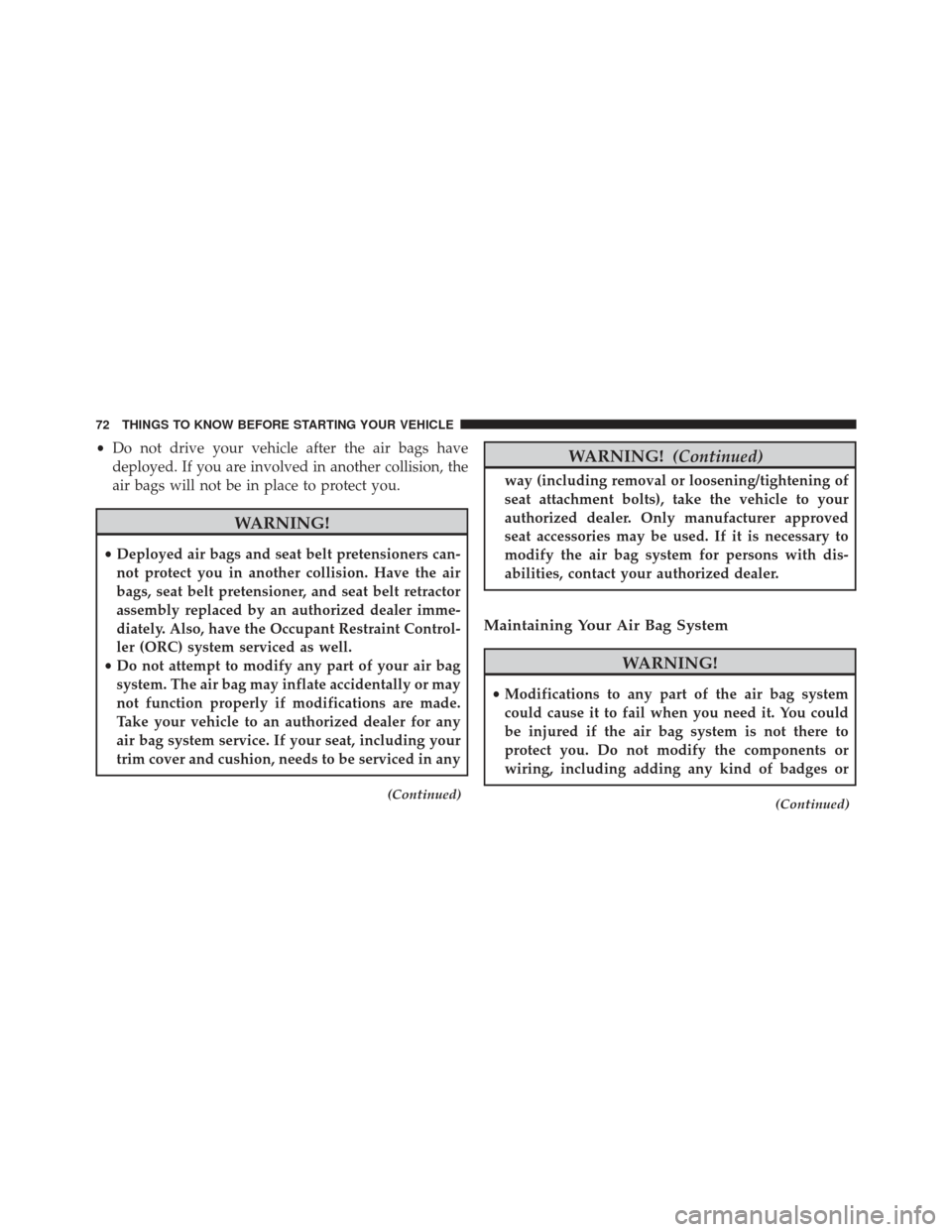
•Do not drive your vehicle after the air bags have
deployed. If you are involved in another collision, the
air bags will not be in place to protect you.
WARNING!
• Deployed air bags and seat belt pretensioners can-
not protect you in another collision. Have the air
bags, seat belt pretensioner, and seat belt retractor
assembly replaced by an authorized dealer imme-
diately. Also, have the Occupant Restraint Control-
ler (ORC) system serviced as well.
• Do not attempt to modify any part of your air bag
system. The air bag may inflate accidentally or may
not function properly if modifications are made.
Take your vehicle to an authorized dealer for any
air bag system service. If your seat, including your
trim cover and cushion, needs to be serviced in any
(Continued)
WARNING! (Continued)
way (including removal or loosening/tightening of
seat attachment bolts), take the vehicle to your
authorized dealer. Only manufacturer approved
seat accessories may be used. If it is necessary to
modify the air bag system for persons with dis-
abilities, contact your authorized dealer.
Maintaining Your Air Bag System
WARNING!
•Modifications to any part of the air bag system
could cause it to fail when you need it. You could
be injured if the air bag system is not there to
protect you. Do not modify the components or
wiring, including adding any kind of badges or
(Continued)
72 THINGS TO KNOW BEFORE STARTING YOUR VEHICLE
Page 75 of 666
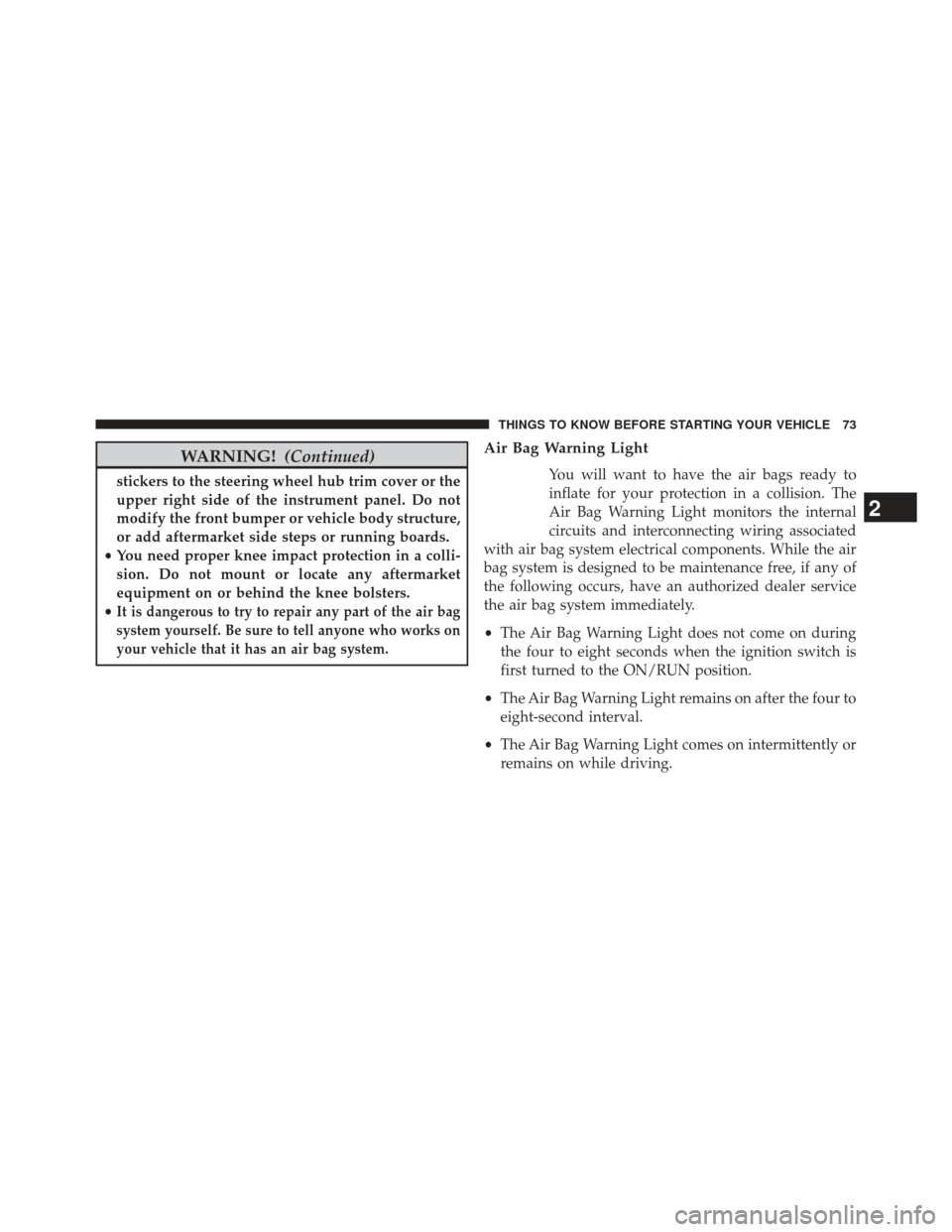
WARNING!(Continued)
stickers to the steering wheel hub trim cover or the
upper right side of the instrument panel. Do not
modify the front bumper or vehicle body structure,
or add aftermarket side steps or running boards.
• You need proper knee impact protection in a colli-
sion. Do not mount or locate any aftermarket
equipment on or behind the knee bolsters.
•
It is dangerous to try to repair any part of the air bag
system yourself. Be sure to tell anyone who works on
your vehicle that it has an air bag system.
Air Bag Warning Light
You will want to have the air bags ready to
inflate for your protection in a collision. The
Air Bag Warning Light monitors the internal
circuits and interconnecting wiring associated
with air bag system electrical components. While the air
bag system is designed to be maintenance free, if any of
the following occurs, have an authorized dealer service
the air bag system immediately.
• The Air Bag Warning Light does not come on during
the four to eight seconds when the ignition switch is
first turned to the ON/RUN position.
• The Air Bag Warning Light remains on after the four to
eight-second interval.
• The Air Bag Warning Light comes on intermittently or
remains on while driving.
2
THINGS TO KNOW BEFORE STARTING YOUR VEHICLE 73
Page 218 of 666
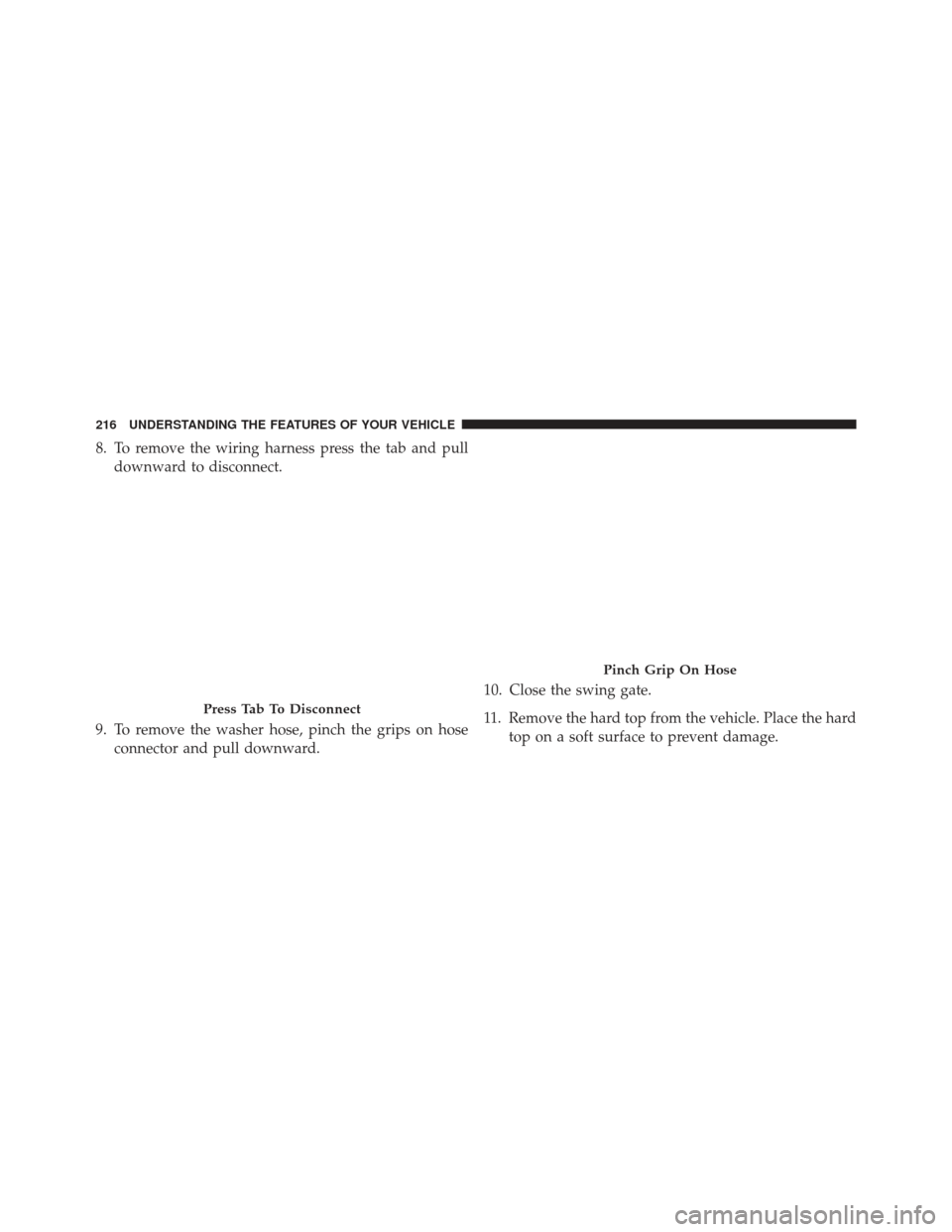
8. To remove the wiring harness press the tab and pulldownward to disconnect.
9. To remove the washer hose, pinch the grips on hose connector and pull downward. 10. Close the swing gate.
11. Remove the hard top from the vehicle. Place the hard
top on a soft surface to prevent damage.
Press Tab To Disconnect
Pinch Grip On Hose
216 UNDERSTANDING THE FEATURES OF YOUR VEHICLE
Page 539 of 666
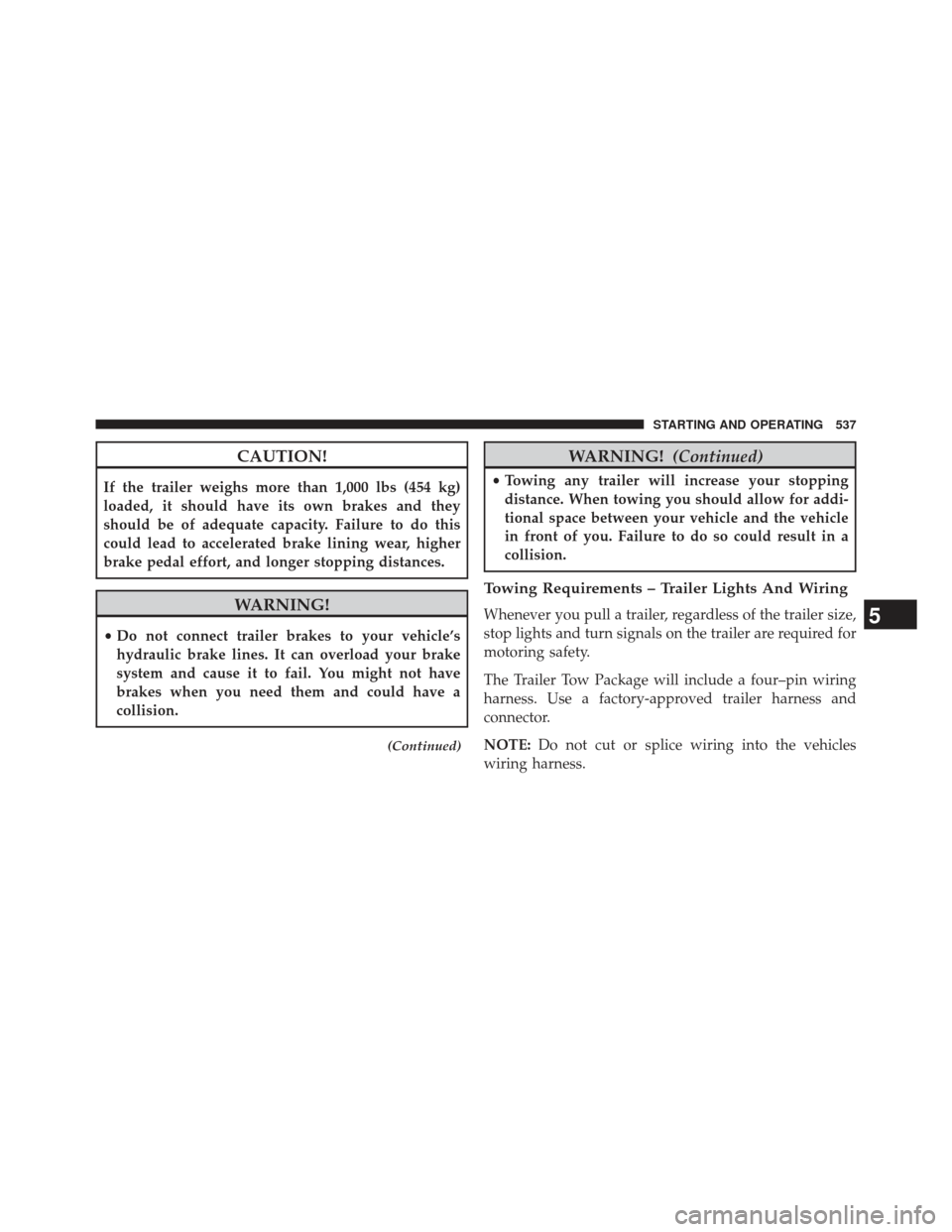
CAUTION!
If the trailer weighs more than 1,000 lbs (454 kg)
loaded, it should have its own brakes and they
should be of adequate capacity. Failure to do this
could lead to accelerated brake lining wear, higher
brake pedal effort, and longer stopping distances.
WARNING!
•Do not connect trailer brakes to your vehicle’s
hydraulic brake lines. It can overload your brake
system and cause it to fail. You might not have
brakes when you need them and could have a
collision.
(Continued)
WARNING! (Continued)
•Towing any trailer will increase your stopping
distance. When towing you should allow for addi-
tional space between your vehicle and the vehicle
in front of you. Failure to do so could result in a
collision.
Towing Requirements – Trailer Lights And Wiring
Whenever you pull a trailer, regardless of the trailer size,
stop lights and turn signals on the trailer are required for
motoring safety.
The Trailer Tow Package will include a four–pin wiring
harness. Use a factory-approved trailer harness and
connector.
NOTE: Do not cut or splice wiring into the vehicles
wiring harness.5
STARTING AND OPERATING 537
Page 662 of 666

Safety.............................. .476
Sizes ............................... .477
Snow Tires ........................... .492
Spare Tire ............................ .549
Spinning ............................ .495
Tread Wear Indicators ....................496
Tire Safety Information .....................476
Tongue Weight/Trailer Weight ................532
To Open Hood .......................... .167
Tow Hooks, Emergency .....................561
Towing ............................... .522
24-Hour Towing Assistance ................130
Disabled Vehicle ....................... .563
Guide .............................. .526
Recreational .......................... .540
Weight .............................. .526
Towing Assistance ........................ .130
Trac-Lok Rear Axle ....................... .437
Traction Control ......................... .461Trailer Sway Control (TSC)
..................473
Trailer Towing .......................... .522
Cooling System Tips .....................539
Hitches ............................. .525
Minimum Requirements ..................533
Trailer and Tongue Weight .................532
Wiring .............................. .537
Trailer Towing Guide ...................... .526
Trailer Weight ........................... .526
Transfer Case ........................... .598
Four-Wheel-Drive Operation ...............433
Maintenance .......................... .598
Transmission ........................... .594
Automatic ........................... .424
Manual ............................. .418
Range
Indicator ....................... .310
Shifting ............................. .422
Transmitter Battery Service (Remote Keyless Entry) . .28
Tread Wear Indicators ..................... .496
660 INDEX
Page 665 of 666
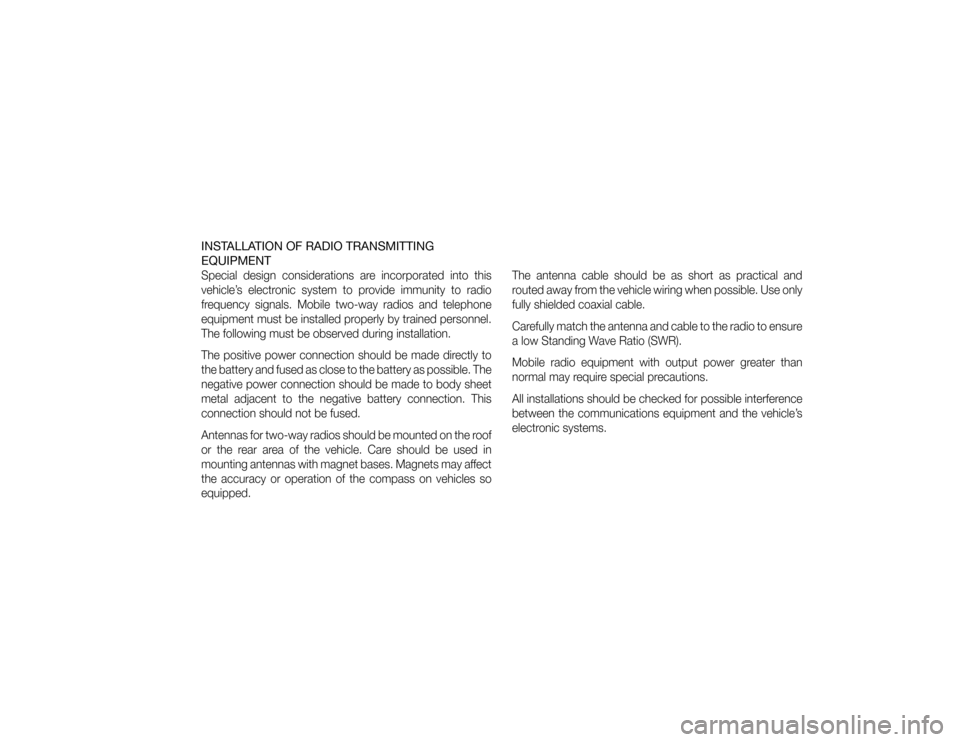
INSTALLATION OF RADIO TRANSMITTING
EQUIPMENTSpecial design considerations are incorporated into this
vehicle’s electronic system to provide immunity to radio
frequency signals. Mobile two-way radios and telephone
equipment must be installed properly by trained personnel.
The following must be observed during installation.
The positive power connection should be made directly to
the battery and fused as close to the battery as possible. The
negative power connection should be made to body sheet
metal adjacent to the negative battery connection. This
connection should not be fused.
Antennas for two-way radios should be mounted on the roof
or the rear area of the vehicle. Care should be used in
mounting antennas with magnet bases. Magnets may affect
the accuracy or operation of the compass on vehicles so
equipped.The antenna cable should be as short as practical and
routed away from the vehicle wiring when possible. Use only
fully shielded coaxial cable.
Carefully match the antenna and cable to the radio to ensure
a low Standing Wave Ratio (SWR).
Mobile radio equipment with output power greater than
normal may require special precautions.
All installations should be checked for possible interference
between the communications equipment and the vehicle’s
electronic systems.